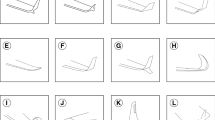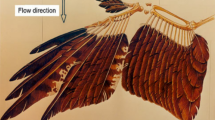Abstract
Desert locusts, tethered on a roll torque meter and flying in a wind tunnel are surrounded by an artificial horizon (Fig. 1). Flight motor activity and movement of forewings are monitored continuously. Movements of the artificial horizon elicit roll manoeuvers of the animal with latencies of several seconds; concomitant changes in flight motor pattern and wing movement can be correlated with the animal's roll angle and roll torque. Flight sequences with constant torque and roll angle (steady state) have been analysed with the following results.
Wing Kinematics. A phase difference between the movements of the forewings on either side is correlated with roll angle (Fig. 3). Pronation of a forewing is always greater on the side to which the animal rolls, i.e. on the side that produces less lift (Fig. 5). In some experiments the slope of the wing tip path is also decreased (Fig. 5). In both cases, the aerodynamic angle of attack is decreased and the forewing on this side produces less lift. In most experiments, changes in pronation are less pronounced in the contralateral wing (Fig. 11). All factors contribute to a net roll torque that sustains the animal's roll angle. Other kinematic parameters of forewing movement, e.g. wing stroke amplitude, were not found to be correlated with roll angle and torque (Fig. 4).
Motor Pattern. Activity of several flight muscles (depressors M97, M98, M99, and M129; elevators M83, M84, and M90) was investigated for changes in burst length and temporal coordination in response to roll stimuli. Most flight muscles fired only once per wing beat cycle in our preparations. Thus, burst length was not found to be correlated with roll angle. Time intervals of firing between all muscle pairs investigated change in correlation with the torque and roll angle (Fig. 9).
All mesothoracic muscles are active earlier-relative to the ipsilateral metathoracic subalar muscle M129-during roll to the ipsilateral side than during roll to the contralateral side.
Correlations Between Motor and Movement Pattern. The phase of muscle firing within the wing beat cycle varies with roll angle (roll torque). The first basalar M97 and second tergosternal M84 muscles, when referenced e.g. to the upper (M97) or lower (M84) reversal point of the wing tip trajectory, are active earlier on the side the animal turns to (Fig. 10). The onset of the first basalar M97 relative to the beginning of downstroke is correlated with maximum pronation and roll angle (Fig. 11).
Mechanisms of Lift Control. Wing pronation, which is very important for lift production is controlled by the central nervous system by altering the phase of muscle activity within the wing beat cycle.
Similar content being viewed by others
References
Camhi JM (1970) Yaw-correcting postural changes in locusts. J Exp Biol 52:519–531
Dubs F (1966) Aerodynamik der reinen Unterschallströmung. Birkhäuser, Basel Stuttgart
Götz KG (1983) Bewegungssehen und Flugsteuerung bei der FliegeDrosophila. In: Nachtigall W (ed) BIONA-report, vol 2. Akad Wiss, Mainz; Fischer, Stuttgart New York, pp 21–34
Goodman LJ (1965) The role of certain optomotor reactions in regulating stability in the rolling plane during flight in the desert locust,Schistocerca gregaria. J Exp Biol 42: 385–407
Hollick B (1940) The flight of the dipterous flyMuscina stabulans Fallen. Phil Trans R Soc SerB 239:511–552
Holst v.E (1943) Über “künstliche Vögel” als Mittel zum Studium des Vogelflugs. J Ornith 91:406–447
Koch U (1977) A miniature movement detector applied to recording of wingbeat in locusta. Fortschr Zool 24 H2/3:327–332
Mittelstaedt H (1950) Physiologie des Gleichgewichtssinnes bei fliegenden Libellen. Z Vergl Physiol 32: 422–463
Möhl B (1985) The role of proprioception in locust flight control. I. Asymmetry and coupling within the time pattern of motor units. J Comp Physiol A 156:93–101
Möhl B, Zarnack W (1977a) Activity of the direct downstroke flight muscles of Locusta migratoria L. during steering behavior in flight. II. Dynamics of the time shift and changes in burst length. J Comp Physiol 118:235–247
Möhl B, Zarnack W (1977b) Activity of direct downstroke flight muscles of the locust. Fortschr Zool 24 H2/3:333–339
Nachtigall W (1979) Rasche Richtungsänderungen und Torsionen schwingender Fliegenflügel und Hypothesen über zugeordnete instationäre Strömungseffekte. J Comp Physiol A 133:351–355
Pfau HK (1978) Funktionsanatomische Aspekte des Insektenflugs. Zool Jb Anat 99:99–108
Robertson RM, Pearson KG (1984) Interneuronal organisation in the flight system of the locust. J Insect Physiol 30:95–101
Rowell HF, Reichert H (1985) Three decending interneurons reporting deviation from course in the locust. II. Physiology. J Comp Physiol A 158:775–792
Schmidt J, Zarnack W (1987) The motor pattern of locusts during visually induced rolling in long-term flight. Biol Cybern 56:397–410
Schwenne T, Zarnack W (1987) Movements of the hindwings ofLocusta migratoria, measured with miniature coils. J Comp Physiol A 160:657–666
Send W (1984) Der instationäre Nachlauf hinter schlanken Auftriebskörpern in inkompressibler Strömung. ZAMM 64:7–15
Thüring DA (1986) Variability of motor output during flight steering in locusts. J Comp Physiol A 158:653–664
Waldmann B (1986) Motorische Muster und Bewegung der Vorderflügel bei optisch induzierten Rollbewegungen im Windkanal fliegender Wüstenheuschrecken. Diplomarbeit, Universität Göttingen
Waldmann B, Zarnack W (1987) Motor activity and movements of forewings during roll manoeuvers in flying desert locusts. In: Elsner N, Creutzfeldt O (eds) New forntiers in brain research. Poster 54. Thieme, Stuttgart New York
Weis-Fogh T (1956) Biology and physics of locust flight. II. Flight performance of the desert locust (Schistocerca gregaria F). Phil Trans R Soc Ser B 239:459–510
Wendler G (1974) The influence of proprioceptive feedback on locust flight coordination. J Comp Physiol A 88:173–200
Wilson DM (1968) Inherent asymmetry and reflex modulation of the locust flight motor pattern. J Exp Biol 48:631–641
Wortmann M, Zarnack W (1987) The influence of several parameters of wing movement on the lift ofSchistocerca gregaria during descending, horizontal, or ascending flight. In: Elsner N, Creutzfeldt O (eds) New frontiers in brain research. Poster 53. Thieme, Stuttgart New York
Zarnack W (1969) Kinematik der Flügelbewegungen beiLocusta migratoria L. Diss, Math-Nat-Fak Universität München
Zarnack W (1975) Aerodynamic forces and their calculation in insect flight. In: Wu ThYT, Brokaw ChJ, Brennen Ch (eds) Symposium on swimming and flying in nature. vol 2. Plenum Press, New York London, pp 797–801
Zarnack W (1978) A transducer recording continuously 3-dimensional rotations of biological objects. J Comp Physiol A 126:161–168
Zarnack W (1982) Kinematische, aerodynamische und neurophysiologisch-morphologische Untersuchungen des Heuschreckenflugs. Habil, Math-Nat-Fak Universität Göttingen
Zarnack W (1983) Untersuchungen zum Flug von Wanderheuschrecken. Die Bewegungen, räumlichen Lagebeziehungen sowie Formen und Profile von Vorder- und Hinterflügeln. In: Nachtigall W (ed) BIONA-report vol. 1:79–102, Akad Wiss, Mainz; Fischer, Stuttgart New York
Zarnack W (1988) The effect of forewing depressor activity on wing movement during locust flight. Biol Cybern 59:55–70
Zarnack W, Möhl B (1977a) Activity of the direct downstroke flight muscles ofLocusta migratoria L. during steering behaviour in flight. I. Pattern of time shift. J Comp Physiol A 118:215–233
Zarnack W, Möhl B (1977b) A data acquisition processor with data reduction for electrophysiological experiments. Fortschr Zool vol 24, H2/3:321–326. Fischer, Stuttgart New York
Author information
Authors and Affiliations
Rights and permissions
About this article
Cite this article
Waldmann, B., Zarnack, W. Forewing movements and motor activity during roll manoeuvers in flying desert locusts. Biol. Cybern. 59, 325–335 (1988). https://doi.org/10.1007/BF00332923
Received:
Published:
Issue Date:
DOI: https://doi.org/10.1007/BF00332923




